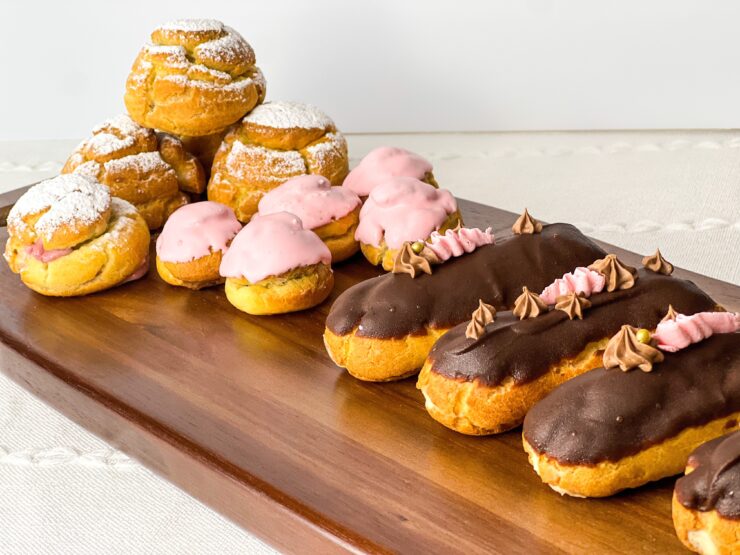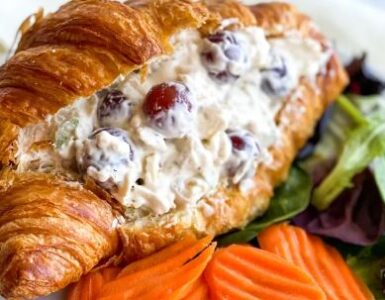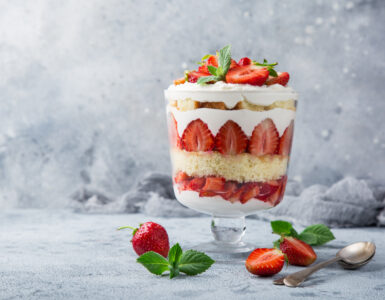Here’s how to make your own French pastries.
It’s like stepping into a Parisian pastry shop. Only, you don’t have to leave the country for this delicate dessert!
Khara Westergard shares a recipe for a special dough used as the base for many French recipes.
Find more recipes from Khara on Instagram, @balsamicbaker.
How to Master French Pastries
Choux is very versatile and can be used for so many things. Choux dough makes eclairs, profiteroles (round puffs), or Choux buns (bigger round puffs), and a variety of other French named shapes. Fry them off in strips for churros, or go savory with added spices and cheese mixed into the dough or just a savory filling. Or boil small bits for a French gnocchi. The options are endless!
It sounds intimidating to most people, but only because it’s French. Khara says it’s actually quite easy. Alone they taste very similar to German pancakes and puffs in much the same way. Making that connection can make them seem less intimidating!
Khara reviews how to make them, prep them on the pan, bake them to make them puff and set so they don’t fall flat, and shares two filling techniques.
Choux Pastry – Pâte à Choux
By Balsamic Baker
For cream puffs, eclairs, profiteroles, churros, French/Persian gnocchi, savory puffs, & more. So many possibilities.
INGREDIENTS
(*see notes for all ingredients with asterix)
- 4 oz. (1/2 C.) Unsalted Butter – cut up for faster melting
- 4 oz. (1/2 C.) Whole Milk (what you have can work in a pinch)*
- 4 oz. (1/2 C.) Water
- 1 Tbsp. (.5 oz.) Granulated Sugar*
- 3/8 t. Salt (omit 1/8 t. & a pinch if using salted butter above.)
- 4.75 oz. – 5 oz. (About 1C. Fluffed) Bread Flour or All-Purpose Flour* – use a scale for best results
- 4 Large Eggs (US Large, UK medium)
METHOD
- Combine butter, milk, water, sugar, & salt in a sauce pan. Stir over medium heat until simmering.
- Remove from heat if needed, returning as needed, as you add the flour all at once. Mix well immediately to distribute all the hot liquid evenly. Your mixture should look like mashed potatoes. Continue stirring breaking up any remaining flour lumps over the heat & cooking out the liquid. Continue until mixture feels more like play dough, falls away from the sides, & develops a film on the bottom of your pan.
- Dump into a mixing bowl to cool 3-5 minutes stirring in short spurts, every so often, to help release heat. Do not leave it mixing for this step, avoid over mixing. I like to leave mixing leeway for the egg additions.
- While waiting, crack eggs & prep 2 bakers 1/2 sheet pans with parchment paper. Spray with clean water to help avoid burnt choux bottoms & help the parchment stick to the pan.
- Add eggs in 4 additions (1 egg at a time for a single batch, 2 at a time for a double batch, etc.). Mix well between each addition. Some people like to hold their last egg back & beat it to add just a bit at a time until the right consistency is reached. I’ve never needed to do that with these weighed measurements. Your ending consistency should flow off the end of your beaters just enough to form a good “V” shape without running off. If too runny, the choux dough won’t hold its shape when piped (try adding a touch more flour). If too thick, you won’t be able to pipe your dough, or it will bake up more dense. Add a bit more egg. Again, these measurements should be just right. If in question, just give it an extra mix & continue on.
- Fill pastry bags fitted with a large round tip or large French star tip (optionally, sub a freezer ziplock bag & cut a rounded hole). Pipe onto parchment lined pans at a straight up & down vertical angle. Do not hold tip too close to the pan. Allow room for dough to fall & fill the space in a rounded shape as it hits the pan. Release pressure & lift away. Wet your finger tip & pat down the peak to finish the shape & avoid a burned peak.
- For eclairs, hold your piping bag at a 45° angle & pipe in a straight line with even pressure. Your pressure will determine the thickness of your éclair. I like to use an ateco 808 tip & make my eclairs only a little bigger than the opening. If they are too big they will end up more like a hot dog bun. Do not pipe too close together or they’ll puff into each other. They will not brown or set on the sides as needed & again will end up looking like a hot dog bun. I like to do 10 per bakers 1/2 sheet pan.
- Bake at 400-415° (depending on your oven) for 20-30 minutes depending on size of Choux buns. The first bake will puff the shape. Drop temperature 25° to finish baking. This second bake time will hope to finish setting the shape without over browning the pastry. DO NOT OPEN THE OVEN DOOR TO CHECK ON CHOUX DURING BAKING. Just look through the window. Very small choux may not need the second bake time. Done choux will be well risen & well browned. If it falls after taking it out of the oven you can return to the oven at the higher heat & hope for the best. Or, just bake more next time. It will still be delicious. Fill as soon as cooled to hopefully recover its shape.
- Inject with fillings, or cut open to fill. Fill style is preference. Fill with pastry cream, whipped cream, diplomat cream, ice cream, savory fillings etc.
- Top with a dusting of powdered sugar, a simple ganache dip*, or herbs.
*Notes
- All-purpose flour is delicious too, but bread flour gives the choux shape more structure. 4.75 oz.of flour is a favorite tender consistency, but 5oz.is better for éclairs or very round shapes.
- Milk can be optional if you substitute it with more water. Traditionally, the French used only water. Still today, some will prefer the crisper shell this produces. Many of us now prefer a more tender, richer shell produced by using milk.
- Sugar is optional. Again it aids in a more tender, richer shell. You can omit for savory applications.
- Simple ganache: Melted chocolate with enough heavy cream to let it run nicely off your spoon. Amount of cream varies for chocolate brand, & type of chocolate (dark, milk, etc.). But milk & white chocolates take 1/4-1/3 of their weight in cream. Dark & semi sweet or bittersweet take around 1/2 or more. I like to add a pinch of salt & vanilla in proportion to cream used. 1/4 t. Vanilla per 1/4 C. Cream. Or, 1/2 t. Vanilla per 1/2 C. Cream. Etc.
- Whip up your cooled leftover ganache & pipe details onto your eclairs for a quick decorative option.
Gluten-Free Adjustments
- Sub flour for a mixture of 3.5 oz. Bob’s Red Mill GF 1to1 baking flour (blue bag, NOT RED), 1 oz. Sorghum Flour (found at Whole Foods or Amazon), 1 oz. Expandex (Amazon).
- Add an extra egg for a total of 5 eggs.
- At every stage, mix just enough to combine ingredients. GF flour does best with minimal mixing. It’ll work, you’ll love it!
*If unable to get Expandex, try subbing with .4 oz extra Sorghum Flour, & .6 oz Tapioca Starch.
Pastry Cream
By Balsamic Baker
Vanilla pastry cream, and how to make many flavor variations, including diplomat cream.
INGREDIENTS
(*see notes for all ingredients with asterix)
- 16 oz. (2 C.) Whole Milk
- 1 Vanilla Bean grade A – split and scraped (add pod & seeds) or sub 1 Tbsp. Vanilla paste or extract
- 4 oz. (1/2 C.) Granulated Sugar* (add up to 2 Tbsp. if preferred)
- 30g – 50g (3 – 5 Tbsp) Cornstarch *see notes!!
- 1/8 t. Salt
- 4 Large Egg YOLKS (US Large, UK medium)
- *1 oz. (2 Tbsp.) Unsalted Butter – Cold & cut up for faster melting. *Omit for flavors other than vanilla! Or, optionally thin as needed after cooling with water instead. See notes!
METHOD
- Bring milk & vanilla (+ any other ingredients of choice that would benefit from steeping, like a zest) to a simmer over low to medium low heat in a sauce pan. Whisk to keep milk from scalding. Once it just reaches a simmer, remove from heat & cover with a lid to allow vanilla pod to steep in the milk & catch the steam/liquid while it cools. Set aside.
- Mix the sugar, cornstarch, & salt together well. Add the egg yolks & mix slowly so the cornstarch doesn’t waft out into the air too much. Once wet, beat the mixture well on a high speed until lightened in color.
- Pull out the vanilla pod, & strain out any other additives necessary.
- Add a ladle scoop of the hot milk into the egg mixture while whisking. Mix until egg mixture is evenly loosened. Slowly add more milk while whisking until all is added together.
- Return to sauce pan & heat over low to medium low heat whisking constantly (probably low for a gas range). A french whisk has the best shape to reach in all the corners of your pot. Scrape all of the surfaces while whisking to avoid scrambling the eggs. Keep cooking & whisking until the mixture thickens, plus a minute longer. When the mixture starts “burping” or boiling, remove from the heat immediately & continue whisking to help it cool.
- Remove from pan immediately into a glass dish for cooling. Or drop butter in if using, whisk together & remove from pan into cooling dish. For faster cooling, spread into a 9×13 dish or a sheet pan for larger batches. Either way, cover with plastic food wrap. Hug food wrap right onto all exposed surface of the pastry cream to avoid developing a skin. Cool in fridge or freezer. Remove when cool.
- Transfer cream to a clean mixing bowl. Whisk gelatinous cream to return it to a cream like texture. Depending on liquid levels lost to steam, & cornstarch levels chosen, you may need to add a splash of water & whisk well to return to a pleasing texture. Add only small amounts at a time. You can always add more as needed, but you can’t take it away. If adding a liquid/juice or loose additive for flavors (see notes!), skip the water & add a splash of the additive to loosen the cream. Use an electric whisk if very stiff & not smooth after first liquid addition. Do not continue to add more liquid if it’s chunky. Smooth it out first. You’ll never get rid of the chunks if you add too much liquid too fast.
- If flavor levels are reached with additives, & you still want it loser for textural preferences, now is the time to add a splash of water if you were refraining from water before in favor of flavor additions. Some prefer a stiff cream, some prefer a loose cream. You are in control!
- Consider lightening a finished cream by folding it with sweetened vanilla whipping cream. This turns it into a diplomat cream! My favorite. But! I’m going to say it: I do not prefer to add a stabilized whipped cream. To me, stabilizing with gelatin ruins the flavor by way of changing the texture. Instead, I recommend opting for a minimally stabilized whipping cream (relying on cornstarch in powdered sugar & a stiff whip). To do this successfully, wait to add this type of cream until you are also ready to fill your pastries. This type of cream is likely to loosen too much if stored away & then manipulated on a later day. If left undisturbed inside a pastry, it will hold its structure better, even days later.
Notes
- Sugar – levels can be up to preference, but I recommend adding the extra sugar for flavors like lemon.
- Cornstarch – 30g for vanilla pastry cream. 40g for a stiffer vanilla cream, or for when adding other flavors. 50g for liquid additives like lemon juice. If you guess wrong on consistency needed, you can always loosen it more with a small splash of water.
- Vanilla – always a compliment to every flavor I can think of. Even citrus, even chocolate, fruits, caramel, all of it. Don’t skip it. But you can save your expensive vanilla beans for when you are doing just vanilla if you wish. Substitute a quality tasting vanilla. Test it: If you don’t enjoy the flavor when mixed with sweetened whipped cream or milk, don’t use it!
- Sweetened Vanilla Whipped Cream (recipe sized for adding to 1 batch pastry cream): 8 oz. (1 C.) Heavy Whipping Cream, 2 oz. (1/2 C. Fluffed) Powdered Sugar, 1 tsp. Vanilla. Whip together until stiff peaks achieved.
- Flavor additive ideas (but please try more):
- Quality Raspberry sauce or a thick but flowing Salted Caramel sauce (I have recipes for both!). Add up to 75% of the pastry cream’s weight in flavored sauce/preserves. Taste along the way for good levels per different sauce recipes. I added about 15 oz of both options per pastry cream recipe.
- Chocolate! Add your own preference of chocolate plus an appropriate cream level for that chocolate to create a simple ganache. Add a touch of salt & vanilla in proportion to the cream. (1/2 t. Van to 1/2 C. Cream). I like a lot of chocolate, but you can opt for much less. For 1 batch pastry cream, I did 8 oz Ghirardelli milk chocolate chips, 6 oz. Ghirardelli Semi-sweet chocolate chips, 2.6 oz. Heavy cream, a generous 1/4 tsp. Vanilla, & 1/8 tsp. Salt. Melt ingredients together, stirring until smooth. Cool before adding to pastry cream. Consider extra sweetened whipped cream for a diplomats version of this flavor.
- Lemon. Add zest of 1 large lemon (1 Tbsp.) to milk in first step. Choose the max amount of cornstarch in recipe. Loosen cooled cream with lemon juice in slow additions up to 3-4 oz. Use freshly squeezed lemon juice, NOT BOTTLED. Amount of lemon juice will depend on acidity levels, & preference.















Add comment